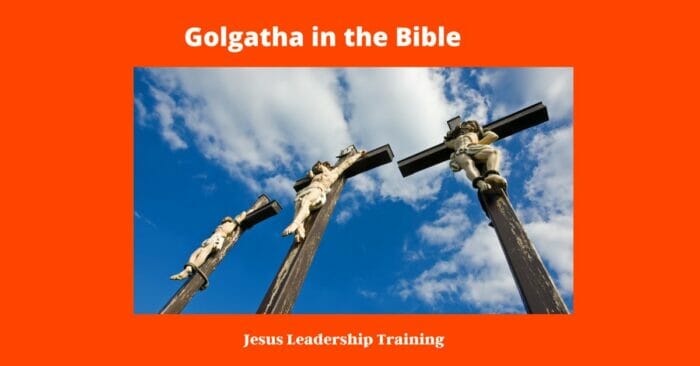Golgatha in the Bible – Golgotha, also known as Calvary or the Place of the Skull, is a site mentioned in the New Testament of the Bible. It is the site of Jesus Christ’s crucifixion and is located on a hill outside of Jerusalem. It is the place where Jesus was crucified and where his body was laid to rest.
Golgotha is an important part of Christian history and serves as a reminder of Jesus’ selfless act of sacrifice for the salvation of mankind. The site is also seen as a place of hope and redemption as it is believed that Jesus’ death and resurrection brought about redemption for all of mankind.
Table of Contents
Golgatha in the Bible
The history of Golgatha, also known as Calvary, is closely intertwined with the history of Jesus Christ. Golgatha, which means “the place of the skull,” is the site of Jesus’s crucifixion and death, and it is believed to have been located in the ancient city of Jerusalem.
Golgatha has been used for various purposes throughout the years. During the time of Jesus, it was used as a public execution site. The Romans used this location to crucify those who had been found guilty of crimes. This was done in order to set an example for other people who may have considered breaking the law.
The exact date of Jesus’s crucifixion is unknown, but scholars believe it was around the year 33 AD. According to the Bible, Jesus was crucified by the Romans on the day before the Passover holiday. After being nailed to the cross, Jesus died after about six hours. His body was then removed from the cross and placed in a tomb.

The site of Golgatha has been a place of pilgrimage for Christians for centuries. Pilgrims have come to this site to remember the sacrifice that Jesus made for humanity. They come to reflect on the life of Jesus and to honor his death.
Today, the site of Golgatha is located in the Church of the Holy Sepulchre in Jerusalem. This church is visited by millions of people each year and is a reminder of the sacrifice that Jesus made for humanity. The site is also a reminder of the hope and faith that can be found in Jesus Christ.
Golgotha in the Bible: A Historical and Religious Exploration
When we think of biblical stories, one of the most powerful and moving stories is the crucifixion of Jesus Christ at Golgotha, or Calvary. In the Bible, Golgotha is mentioned several times, and is of great religious and historical significance. In this blog, we will explore the history of Golgotha in the Bible and what it means today.
What is Golgotha in the Bible?
Golgotha is mentioned multiple times in the Bible, often referred to as Calvary. The word “Golgotha” is derived from the Hebrew “Gulgolet”, which means “skull”. The term “Calvary” is derived from the Latin word “calvaria”, which means “place of a skull”. In the Bible, Golgotha is the place where Jesus was crucified.

The History of Golgotha in the Bible
Golgotha is mentioned several times in the Bible. In the Gospels of Matthew, Mark, and Luke, it is written that Jesus was crucified at Golgotha outside of Jerusalem. In the book of John, it is written that Jesus was crucified at a different place, but some biblical scholars believe that this was a copyist error, and that the other three Gospels are correct in saying that Jesus was crucified at Golgotha.
The Uses of Golgotha in the Bible
Golgotha is used in the Bible to refer to the place of Jesus’ crucifixion. The Bible also mentions Golgotha in relation to the crucifixion of two criminals that were crucified with Jesus. It is also used in the book of John to refer to the place where Jesus was buried.
The Meaning of Golgotha in the Bible
Golgotha is a place of great religious and historical significance. In the Bible, Golgotha symbolizes the place where Jesus was crucified and died for the sins of mankind. It is also a symbol of the great suffering and sacrifice that Jesus endured in order to bring salvation to mankind.

When Was Golgotha Mentioned in the Bible?
Golgotha is mentioned in the Gospels of Matthew, Mark, and Luke, as well as the book of John. It is also mentioned in the book of Acts, and in several other books in the New Testament.
Where Is Golgotha Mentioned in the Bible?
Golgotha is mentioned in the Gospels of Matthew, Mark, and Luke, as well as the book of John. It is also mentioned in the book of Acts, and in several other books in the New Testament.
Why Was Golgotha Mentioned in the Bible?
Golgotha is mentioned in the Bible because it is the place where Jesus Christ was crucified and died for the sins of mankind. It is also mentioned in order to remind us that Jesus suffered greatly in order to bring salvation to mankind.
The Biblical Significance of Golgotha
Golgotha is of great significance in the Bible. It is the place where Jesus was crucified and died for the sins of mankind. It is also a reminder of the great suffering and sacrifice that Jesus endured in order to bring salvation to mankind.
The Hebrew Meaning of Golgotha
The word “Golgotha” is derived from the Hebrew “Gulgolet”, which means “skull”. This is symbolic of the death and suffering that Jesus endured in order to bring salvation to mankind.
- Golgatha: גולגלתא (Golgalta) – This is the Hebrew name of the hill outside Jerusalem where Jesus was crucified, and is derived from the Aramaic word for skull or head.
- Calvary: גלבוע (Golbo’a) – This is the Hebrew name for the hill of crucifixion, and is derived from the Hebrew word for skull or head.
- G’vul Gahat – גבול גחת – This translates to “place of the skull” which is the literal translation of Golgatha.
- G’vul Hamoger – גבול המוגר – This translates to “the place of the scullary”, which is another literal translation of Golgatha.
- Har Hamelech – הר המלך – This translates to “mount of the king” which is a poetic translation of Golgatha.
- Har HaGevurah – הר הגבורה – This translates to “mount of might”, which is a symbolic translation of Golgatha.
- Har HaKavod – הר הכבוד – This translates to “mount of honor”, which is another symbolic translation of Golgatha.
- Har HaEmet – הר האמת – This translates to “mount of truth”, which is yet another symbolic translation of Golgatha.
- Har HaKavod – הר הכבוד – This translates to “mount of glory”, which is a further symbolic translation of Golgatha.
The Greek Meaning of Golgotha
- Κρανίον (Kranion): This is the most commonly used Greek word for Golgatha, as it was originally derived from the Latin word for skull. It refers to the hill where Jesus was crucified and is typically used in religious contexts.
- Τόπος του Σταυρού (Topos tou Stavrou): This literally translates to “place of the cross” and is another commonly used word to describe Golgatha.
- Τόπος των Σταυρισμών (Topos ton Stavrismon): This literally translates to “place of crucifixions” and is used to describe Golgatha in a more general context.
- Κρανιούπολη (Kranioupoli): This literally translates to “Skull City” and is used to refer to the hill of Golgatha in a more poetic manner.
- Γολγοθά (Golgotha): This is the exact transliteration of the Hebrew word for Golgotha, which is the most likely origin of the name.
- Καλών (Kalon): This literally translates to “good” and is used to describe the hill of Golgatha in a more positive light.
- Σταυροφόρος (Stavrophoros): This literally translates to “cross-bearer” and is used to describe Golgatha as the place where Jesus was crucified.
The Aramaic Meaning of Golgotha
- Ggulgalta (גֻּלְגַּלְתָּא): This is an Aramaic word meaning “skull” or “place of the skull.” It is frequently used to refer to Golgotha, the site of Jesus’ crucifixion.
- Kraníon (κρανίον): This is a Greek word meaning “skull.” It is also used to refer to Golgotha.
- Calvary (from Latin calvaria): This is a Latin word derived from calvaria, meaning “skull.” It is also used to refer to Golgotha.
- Golgotha (from Hebrew gulgolet): This is a Hebrew word derived from gulgolet, meaning “skull.” It is the traditional name for the site of Jesus’ crucifixion.
- Gagulta (ܓܓܘܠܓܠܬܐ): This is an Aramaic word meaning “skull” or “place of the skull.” It is also used to refer to Golgotha.
- Galgultha (גַּלְגֻּלְתָּא): This is an Aramaic word meaning “skull” or “place of the skull.” It is also used to refer to Golgotha.
The Latin Meaning of Golgotha
- Calvaria: From the Latin “calvaria,” which translates to “skull,” this term refers to Golgotha, the hill on which Jesus was crucified.
- Calvariae Locum: This Latin phrase translates to “place of the skull,” another name for Golgotha.
- Calvarias: This Latin word translates to “skulls,” a reference to the hill on which Jesus was crucified.
- Calvariae Mons: This Latin phrase translates to “mount of the skull,” another name for Golgotha.
- Golgotha: From the Latin “golgotha,” which translates to “skull,” this term refers to the hill on which Jesus was crucified.
- Calvariae Columnae: This Latin phrase translates to “columns of the skull,” a reference to the two crosses at Golgotha.
- Calvariae Locus: This Latin phrase translates to “place of the skull,” another name for Golgotha.
- Calvariae Lapis: This Latin phrase translates to “stone of the skull,” a reference to the stone which was placed over Jesus’ tomb.
Bible Verses About Golgotha
There are several Bible verses that mention Golgotha. Here are a few:
Matthew 27:33 – “And when they came to a place called Golgotha (which means Place of a Skull), they offered Him wine to drink, mixed with gall; but when He tasted it, He would not drink it.”
Mark 15:22 – “And they brought Him to the place Golgotha, which is translated, Place of a Skull.”
John 19:17 – “And He, bearing His cross, went out to a place called the Place of a Skull, which is called in Hebrew, Golgotha.”
How Jesus Christ Was Crucified at Golgotha
The Bible tells us that Jesus was crucified at Golgotha. He was nailed to the cross and hung there until He died. His death on the cross was a powerful symbol of His great sacrifice and love for mankind.
The Symbolism of the Skull at Golgotha
The skull is a powerful symbol in the Bible, and it is mentioned several times in relation to Golgotha. The skull symbolizes death, and it reminds us of the death and suffering that Jesus endured in order to bring salvation to mankind.
The Place of Golgotha in Jesus’ Crucifixion
Golgotha was the place of Jesus’ crucifixion, and it is of great religious and historical significance. It reminds us of the great suffering and sacrifice that Jesus endured in order to bring salvation to mankind.
Golgotha Hill in the Bible
In the Bible, Golgotha is mentioned as a hill outside of Jerusalem. It is believed that this hill was located on the western side of the city, and it is a place of great religious and historical significance.
Golgotha and Jesus’ Resurrection
Golgotha is also mentioned in the Bible in relation to Jesus’ resurrection. In the book of Matthew, it is written that after Jesus was resurrected
Golgotha in Today’s World
Golgotha is still a place of great religious and historical significance. Today, it is a popular destination for pilgrims and tourists who want to visit the place where Jesus was crucified. It is also a reminder of the great suffering and sacrifice that Jesus endured in order to bring salvation to mankind.
Unique Facts about Golgatha
- Golgotha is the Aramaic term for the site of Jesus’ crucifixion, which translates to “the place of the skull”. The name is derived from the shape of the hill, which resembles a skull.
- Golgotha is known to have existed since the time of Jesus and is mentioned in the New Testament of the Bible. It is believed to be located near the present-day Church of the Holy Sepulchre in Jerusalem.
- Golgotha is one of the holiest sites in Christianity and has been visited by pilgrims since the 4th century.
- In the Bible, Golgotha is described as a place where Jesus was crucified with two other men, at the orders of Pontius Pilate.
- Golgotha is believed to be the site of the three-day Easter celebration, commemorating Jesus’ resurrection from the dead.
- Pilgrims to Golgotha often leave small stones, as a sign of their devotion and as a reminder of Jesus’ sacrifice.
- In 1883, a tomb was discovered at the site of Golgotha. It is believed to be the tomb of Jesus and is known as the Edicule.
- In the 19th century, Golgotha was the site of a battle between the forces of the Ottoman Empire and the British Empire.
- The Church of the Holy Sepulchre, which is located near Golgotha, is believed to be the site of Jesus’ burial and resurrection.
- In 2010, a team of archaeologists discovered a small piece of limestone near Golgotha which is believed to be a fragment of the original cross on which Jesus was crucified.
Exploring the Significance of Golgotha in the Bible
Golgotha is of great religious and historical significance. In the Bible, it is the place where Jesus was crucified, and it is a reminder of the great suffering and sacrifice that Jesus endured in order to bring salvation to mankind. Today, it is a popular destination for pilgrims and tourists who want to learn more about the significance of Jesus’ crucifixion.
Final Thoughts – What Does the Bible Say about Golgatha
Golgotha is mentioned multiple times in the Bible, and it is of great religious and historical significance. In the Bible, Golgotha is the place where Jesus was crucified, and it symbolizes the great suffering and sacrifice that Jesus endured in order to bring salvation to mankind. Today, it is a popular destination for pilgrims and tourists who want to learn more about the significance of Jesus’ crucifixion.




